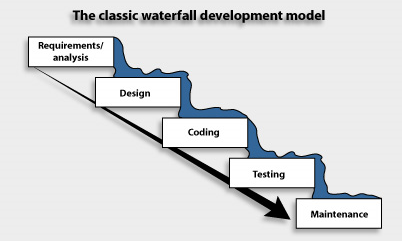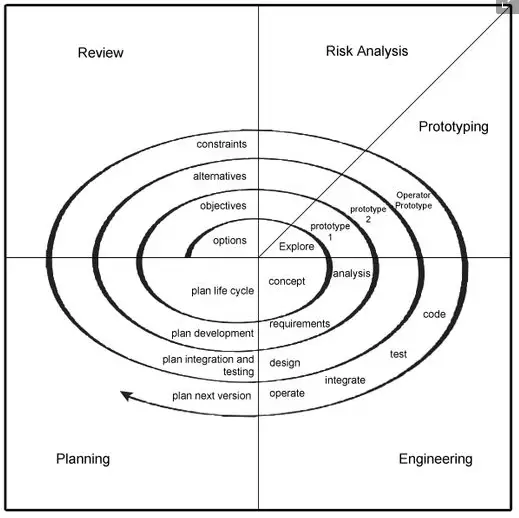The Software Development Life Cycle (SDLC) Process is the structured approach to developing software for a system or project, sometimes called the Software Development Life Cycle (SDLC). There are several approaches (see Software Development Approaches) that can be used, including waterfall, spiral, and incremental development. These different approaches will focus the testing effort at different points in the development process. However, each approach is composed of the same basic steps of development. The incremental development approach typically forms the basis for software development within the larger systems level of Evolutionary Acquisition (EA). [1,2]
Definition: A software development process is a way to improve design and product management by breaking software development work into smaller steps or sub-processes that can be done in parallel or in-order.
Goal of a Software Development Process
An effective software development process aims to minimize risks, guarantee effective resource management, and provide high-caliber software that surpasses customers’ expectations.
Purpose of a Software Development Process
A solid software development process ensures that high-quality software products are made quickly and well. A well-thought-out and well-executed method has several advantages:
- Quality assurance: A solid method puts quality first at every step, from figuring out what needs to be done to testing and putting it into action. It includes things like code reviews, testing methods, and quality assurance techniques, which help find mistakes, bugs, and security holes early in the development process so they can be fixed.
- Consistency and repeatability: A well-defined method gives software development a consistent framework. It spells out the steps, roles, and tasks, ensuring each project uses the same method. This consistency lets teams repeat good practices, reuse parts, and build on what they’ve already done, which increases output and reduces risks.
- Collaboration and coordination: A robust process makes it easier for team members to work together by giving clear instructions and routines. It makes it easier for people with different jobs and responsibilities, like developers, designers, testers, and project managers, to talk to each other, share information, and work together. When people work together, there are fewer misunderstandings, and development cycles go more smoothly.
- Risk management: A set method helps find and deal with risks throughout the software development lifecycle. It has ways to figure out the risks, how to deal with them, and what to do if something goes wrong. By dealing with possible problems early on, the process reduces the chances that the project will be late, cost more than expected, or fail in a major way.
- Scalability and efficiency: A robust process makes scaling possible by letting teams work on bigger and more complicated projects. It helps with allocating resources, sharing work, and putting tasks in order of importance. With well-defined processes in place, organizations can get the most out of their development efforts, shorten the time it takes to get a product on the market and adapt to changes in project needs.
- Continuous improvement: One of the most important parts of a strong software development process is constantly focusing on improving things. It supports looking at past projects, lessons learned, and feedback loops to find places where things could be better. By reviewing and improving the process on a regular basis, companies can improve their software development skills, encourage new ideas, and stay competitive in a field that is changing quickly.
Software Development Lifecycle (SDLC)
The Software Development Life Cycle (SDLC) Process is the structured approach to developing software for a system or project. The software industry employs a methodical process to conceive, construct, and verify software of superior quality. The primary objective of the SDLC is to provide software of superior quality that fulfills or surpasses customer expectations and is completed within the projected time and cost estimates.
Definition: The Software Development Life Cycle Process is a way to improve design and product management by breaking software development work into smaller steps or sub-processes that can be done in parallel or in-order.
Software Development Lifecycle (SDLC) Process Steps
The software development process consists of four major steps. Each of these steps is detailed below.
- Step 1: Planning
- Step 2: Implementing
- Step 3: Testing
- Step 4: Deployment and Maintenance
Step #1: Planning
An important task in creating a software program is Requirements Analysis. Customers typically have an abstract idea of what they want as an end result, but not what software should do. Skilled and experienced software engineers recognize incomplete, ambiguous, or even contradictory requirements at this point. Frequently demonstrating live code may help reduce the risk that the requirements are incorrect. Once the general requirements are gathered from the client, an analysis of the scope of the development should be determined and clearly stated. This is often called a Statement of Objectives (SOO). [1]
Step #2: Implementation
Implementation is the part of the process where software engineers program the code for the project.
Step #3: Testing
Software testing is an integral and important phase of the software development process. This part of the process ensures that defects are recognized as soon as possible. It can also provide an objective, independent view of the software to allow users to appreciate and understand the risks of software deployment. Software testing can be stated as the process of validating and verifying that a software program/application/product: [1,2]
- meets the requirements that guided its design and development;
- works as expected; and
- can be implemented with the same characteristics.
Step #4: Deployment and Maintenance
Deployment starts after the code is appropriately tested, approved for release, and sold or distributed into a production environment. This may involve installation, customization, testing, and an extended evaluation period. Training and support are important, as the software is only effective if used correctly. Maintaining and enhancing software to cope with newly discovered faults or requirements can take substantial time and effort, as missed requirements may force software redesign. Each project action is written down to be used as a reference and improved in the future. [1]
AcqNotes Tutorial
Software Development Plan (SDP)
The Software Development Plan (SDP) describes a developer’s plans for conducting a software development effort. The SDP provides the acquirer insight and a tool for monitoring the processes to be followed for software development. It also details methods and the approach to be followed for each activity, organization, and resource. The software development process should be detailed in the SDP.
Software Development Approaches
The Software Development Approaches below show how the various tasks related to software development can be organized. Typical approaches or paradigms encountered in DoD software development include waterfall, incremental, and spiral, as described below. The incremental development approach typically forms the basis for software development within the larger systems level of Evolutionary Acquisition (EA).
Types of Software Development Approaches
There are four main types of software development approaches. These are:
- Waterfall Approach
- Incremental Approach
- Spiral Approach
- Agile and Scrum
Waterfall Approach
Development activities are performed in order, with possibly minor overlap, but with little or no iteration between activities. User needs are determined, requirements are defined, and the full system is designed, built, and tested for ultimate delivery at one point in time. A document-driven approach best suited for highly precedence systems with stable requirements.
The waterfall model is often also referred to as the linear and sequential model, for the flow of activities in this model are rather linear and sequential as the name suggests. In this model, the software development activities move to the next phase only after the activities in the current phase are over. However, as with a waterfall, one cannot return to the previous stage.

Incremental Approach
Determines user needs and defines the overall architecture, but then delivers the system in a series of increments (“software builds”). The first build incorporates a part of the total planned capabilities, the next build adds more capabilities, and so on, until the entire system is complete.
Spiral Approach
A risk-driven controlled prototyping approach that develops prototypes early in the development process to specifically address risk areas followed by an assessment of prototyping results and further determination of risk areas to prototype. Areas that are prototyped frequently include user requirements and algorithm performance. Prototyping continues until high-risk areas are resolved and mitigated to an acceptable level.
During each iteration or loop, the system is explored at greater depth, and more detail is added. Appropriate for exploratory projects that are working in an unfamiliar domain or with unproven technical approaches. The iterative nature allows for knowledge gained during early passes to inform subsequent passes. Requires low up-front commitment.

Agile and Scrum Approach
The Agile software development process and its most popular method, Scrum, use a dynamic and iterative way to build software. In contrast to the strict, sequential flow of the Waterfall process, cross-functional teams in Agile work in “Sprints” of a week or a few months to build and release software that customers can use and give feedback on. Agile is all about moving quickly, putting out new versions often, and responding to what your users really need, even if that goes against what you had planned. This means you don’t need a full list of requirements and a full SOW before starting work. Instead, you move in one direction with the idea that you will change directions along the way.
Software Development Process Metrics
Software metrics should be an integral part of the software development processes. Program Management Offices (PMO) should gain insight into proposed metrics during source selection, and developers should commit to the consistent use of those metrics, including collecting, analyzing, and reporting. Metrics chosen for use should be defined in the Software Development Plan (SDP). Software metrics should: [1]
- Be integral to the developer‘s processes.
- Clearly portray variances between planned and actual performance.
- Provide early detection or prediction of situations that require management attention.
- Support the assessment of the impact of proposed changes on the program.
AcqLinks and References:
- USAF Weapon Systems Software Management Guidebook – 15 Aug 2008
- Mil-STD-498 “Software Development and Documentation” – 5 Dec 1994
- MIL-STD-498 “Application and Reference Guidebook” – 3 Jan 1996
- Software Development Plan Information Outline
- Template: Software Development Plan – SPAWAR
Updated: 2/14/2024
Rank: G3.7


